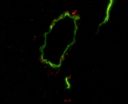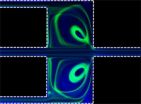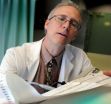(Press-News.org) Our master circadian clock resides in a small group of about 10'000 neurons in the brain, called the suprachiasmatic nucleus. However, similar clocks are ticking in nearly all cells of the body, as demonstrated by the group of Ueli Schibler, professor at the Department of Molecular Biology of the University of Geneva, Switzerland. The molecular mechanisms of circadian clocks can thus be studied outside of the animals, in cultured cells.
A system to study gene regulation live in single cells
"Given the important role of the DBP protein in the regulation of detoxifying enzymes, we were interested in studying the molecular mechanisms underlying the rhythmic transcription of the DBP gene", points out the biologist, who is member of the NCCR Frontiers in Genetics. To do so, his team devised an elegant method to watch directly under the microscope how the clock's molecular "cogwheels" govern the activity rhythms of this gene in individual living cells.
To this end, the scientists engineered a cell line with a piece of a chromosome exclusively composed of repeated DBP gene copies. They showed that the daily transcription of DBP is due to the rhythmic association of an essential clock component, the transcription factor BMAL1. "This is the first time a transcription factor binding to a circadian gene could be visualized in real time in single cells" explains Markus Stratmann, first author of the article.
The clock transcription factor must be sacrificed
To their surprise, the scientists found that the clock protein BMAL1 is destroyed while stimulating the expression of the DBP gene. By applying a variety of sophisticated imaging and biochemical techniques, they showed that the BMAL1 molecules bound to the DBP gene are degraded by an intracellular protein destruction machine, termed the proteasome.
Curiously, the chopping of the triggering protein BMAL1 is absolutely required for the efficient activation of the DBP gene. In other words, BMAL1 must die while embracing that gene in order to do its job. "In a sense, these transcription factors have the same cruel fate as males of the carnivorous insect Mantis. Sadly, Mantis females decapitate and then start eating their partners before the act of love is even completed" says Markus Stratmann.
At the moment, the biologists can only speculate about the broader impact of their findings. "We do not yet understand why the destruction of the BMAL1 protein is mandatory for the optimal functioning of the DBP gene" remarks Ueli Schibler. In fact, BMAL1 molecules regulate the daily activity of many other genes without getting killed while doing their work. The researchers noticed, however, that genes whose activity is not associated with the destruction of BMAL1 are expressed many hours later than the DBP gene. Their work thus offers a plausible explanation to the enigma of how one and the same transcription factor, BMAL1, can impose dramatically different daily cycles of gene expression.
INFORMATION:
Watching the cogwheels of the biological clock in living cells
2012-10-26
ELSE PRESS RELEASES FROM THIS DATE:
Researchers decipher the mecanism of membrane fission
2012-10-26
A cell is composed of a nucleus which encloses its genetic information and the cytoplasm which is itself confined by an external membrane separating the cell from the outside world. The impermeability of the membrane and its ability to repair itself protect the cell from its environment. Although this membrane resistance is fundamental to the survival of the cell, the cell also needs to let in particles necessary for its proper functioning. The mechanism by which a small region of the cytoplasmic membrane invaginates to form a bud that will then be sectioned off to let ...
Salk study finds diabetes raises levels of proteins linked to Alzheimer's features
2012-10-26
Growing evidence suggests that there may be a link between diabetes and Alzheimer's disease, but the physiological mechanisms by which diabetes impacts brain function and cognition are not fully understood. In a new study published in Aging Cell, researchers at the Salk Institute for Biological Studies show, for the first time, that diabetes enhances the development of aging features that may underlie early pathological events in Alzheimer's.
Specifically, the Salk team found increases in two hallmarks of Alzheimer's-accumulations of amyloid beta (Abeta) and tau protein-in ...
Footwear forensics
2012-10-26
A new computer algorithm can analyze the footwear marks left at a crime scene according to clusters of footwear types, makes and tread patterns even if the imprint recorded by crime scene investigators is distorted or only a partial print.
Footwear marks are found at crime scenes much more commonly than fingerprints, writes a team from the University at Buffalo, New York, in a forthcoming issue of the International Journal of Granular Computing, Rough Sets and Intelligent Systems. They point out that while footprints are common they are often left unused by forensic scientists ...
'NHS should replace traditional autopsies with non-invasive alternative'
2012-10-26
The NHS should implement a non-invasive alternative to autopsies, according to a Department of Health-commissioned report by leading UK experts within the field of post-mortem cross-sectional imaging.
The NHS Implementation Sub-Group of the Department of Health's Post Mortem, Forensic and Disaster Imaging Group (PMFDI) has called on the NHS to adopt post-mortem cross-sectional imaging for as an adjunct to, and under the right circumstances, a replacement for autopsies.
The group, chaired by Professor Guy Rutty, Chief Forensic Pathologist to the East Midlands Forensic ...
Media and content digitization benefits consumers, but revenues lag behind
2012-10-26
Digital spending - the acquisition of media products in digital format - tripled from 2006 to 2010 worldwide, with the recording music sector now achieving 30% of its global sales in the digital market. The digital success of the music sector contrasts other media and content industries, which are moving at a slower pace towards digital with distribution. Only 6% of film/video, newspapers, magazines and book sales were digital, according to the Joint Research Centre's (JRC) report on "The media and content industries. A quantitative overview", which represents an important ...
New options for ease and accuracy in extraction of rare cells or separating blood
2012-10-26
At the Sixteenth International Conference on Miniaturized Systems for Chemistry and Life Sciences (microTAS) to be held Oct. 28-Nov. 1, in Okinawa, Japan, University of Cincinnati researchers will present four papers, including one detailing improvements in rare cell isolation and one detailing improvements, in terms of cost and time, of common blood tests.
Ian Papautsky, associate professor in UC's School of Electronic and Computing Systems (SECS), part of the College of Engineering and Applied Science, and a UC team are leading these research efforts.
In a paper titled ...
Magnetic brain stimulation treats depression independent of sleep effect
2012-10-26
AUGUSTA, Ga. – While powerful magnetic stimulation of the frontal lobe of the brain can alleviate symptoms of depression, those receiving the treatment did not report effects on sleep or arousal commonly seen with antidepressant medications, researchers say.
"People's sleep gets better as their depression improves, but the treatment doesn't itself cause sedation or insomnia." said Dr. Peter B. Rosenquist, Vice Chair of the Department of Psychiatry and Health Behavior at the Medical College of Georgia at Georgia Health Sciences University.
The finding resulted from ...
Minimizing mining damage with manure
2012-10-26
This press release is available in Spanish.U.S. Department of Agriculture (USDA) research confirms that the time-tested practice of amending crop soils with manure also can help restore soils on damaged post-mining landscapes.
Thousands of acres of land with little or no vegetation, once mined for lead and zinc, remain throughout an area of southwestern Missouri, southeastern Kansas, and northeastern Oklahoma. The mining activities also left behind a legacy of lead-contaminated acidic soils, toxic smelter sites, and large quantities of mine tailings called "chat."
Soil ...
Mayo Clinic researchers develop new tools to better treat ADHD patients in early stages
2012-10-26
SAN FRANCISCO -- Mayo Clinic researchers are presenting new findings on the early treatment of child and adolescent attention deficit hyperactivity disorder this week at the American Academy of Childhood and Adolescent Psychiatry annual meeting in San Francisco. They include a method to get better input from parents and teachers of children who are being diagnosed with ADHD for the first time -- allowing for more effective treatment upon the first consultation. Researchers also showed how a tool can help clinicians better diagnose and treat children who have both ADHD and ...
Moffitt Researchers find genetic predictors of fatigue for some prostate cancer patients
2012-10-26
Researchers at Moffitt Cancer Center and the University of South Florida have found that men with prostate cancer who receive androgen deprivation therapy may predictably suffer from fatigue if they have single nucleotide polymorphisms in three pro-inflammatory genes. The discovery highlights the importance of personalized medicine, in which therapies are tailored to a patient's genetic profile.
The study appears in the October issue of Brain, Behavior, and Immunity.
"Few studies have examined the role of genes in cancer-related fatigue and none, to our knowledge, ...



